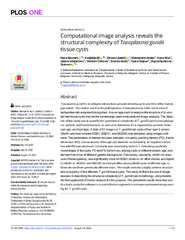Приказ основних података о документу
Computational image analysis reveals the structural complexity ofToxoplasma gondiitissue cysts
| dc.creator | Bauman, Neda | |
| dc.creator | Ilić, Anđelija | |
| dc.creator | Lijeskić, Olivera | |
| dc.creator | Uzelac, Aleksandra | |
| dc.creator | Klun, Ivana | |
| dc.creator | Srbljanović, Jelena | |
| dc.creator | Ćirković, Vladimir | |
| dc.creator | Bobić, Branko | |
| dc.creator | Štajner, Tijana | |
| dc.creator | Đurković-Đaković, Olgica | |
| dc.date.accessioned | 2021-04-20T13:09:29Z | |
| dc.date.available | 2021-04-20T13:09:29Z | |
| dc.date.issued | 2020 | |
| dc.identifier.issn | 1932-6203 | |
| dc.identifier.uri | http://rimi.imi.bg.ac.rs/handle/123456789/1046 | |
| dc.description.abstract | Toxoplasma gondiiis an obligate intracellular parasite infecting up to one third of the human population. The central event in the pathogenesis of toxoplasmosis is the conversion of tachyzoites into encysted bradyzoites. A novel approach to analyze the structure ofin vivo-derived tissue cysts may be the increasingly used computational image analysis. The objective of this study was to quantify the geometrical complexity ofT.gondiicysts by morphological, particle, and fractal analysis, as well as to determine if it is impacted by parasite strain, cyst age, and host type. A total of 31 images ofT.gondiibrain cysts of four type-2 strains (Me49, and local isolates BGD1, BGD14, and BGD26) was analyzed using ImageJ software. The parameters of interest included diameter, circularity, packing density (PD), fractal dimension (FD), and lacunarity. Although cyst diameter varied widely, its negative correlation with PD was observed. Circularity was remarkably close to 1, indicating a perfectly round shape of the cysts. PD and FD did not vary among cysts of different strains, age, and derived from mice of different genetic background. Conversely, lacunarity, which is a measure of heterogeneity, was significantly lower for BGD1 strain vs. all other strains, and higher for Me49 vs. BGD14 and BGD26, but did not differ among Me49 cysts of different age, or those derived from genetically different mice. The results indicate a highly uniform structure and occupancy of the differentT.gondiitissue cysts. This study furthers the use of image analysis in describing the structural complexity ofT.gondiicyst morphology, and presents the first application of fractal analysis for this purpose. The presented results show that use of a freely available software is a cost-effective approach to advance automated image scoring forT.gondiicysts. | en |
| dc.publisher | Public Library Science, San Francisco | |
| dc.relation | info:eu-repo/grantAgreement/MESTD/Integrated and Interdisciplinary Research (IIR or III)/41019/RS// | |
| dc.relation | info:eu-repo/grantAgreement/MESTD/inst-2020/200015/RS// | |
| dc.rights | openAccess | |
| dc.rights.uri | https://creativecommons.org/licenses/by/4.0/ | |
| dc.source | PLoS One | |
| dc.title | Computational image analysis reveals the structural complexity ofToxoplasma gondiitissue cysts | en |
| dc.type | article | |
| dc.rights.license | BY | |
| dc.citation.issue | 8 | |
| dc.citation.other | 15(8): - | |
| dc.citation.rank | M22~ | |
| dc.citation.spage | e0234169 | |
| dc.citation.volume | 15 | |
| dc.identifier.doi | 10.1371/journal.pone.0234169 | |
| dc.identifier.fulltext | http://rimi.imi.bg.ac.rs/bitstream/id/37/1043.pdf | |
| dc.identifier.pmid | 32810131 | |
| dc.identifier.scopus | 2-s2.0-85089649739 | |
| dc.identifier.wos | 000563451300045 | |
| dc.type.version | publishedVersion |

